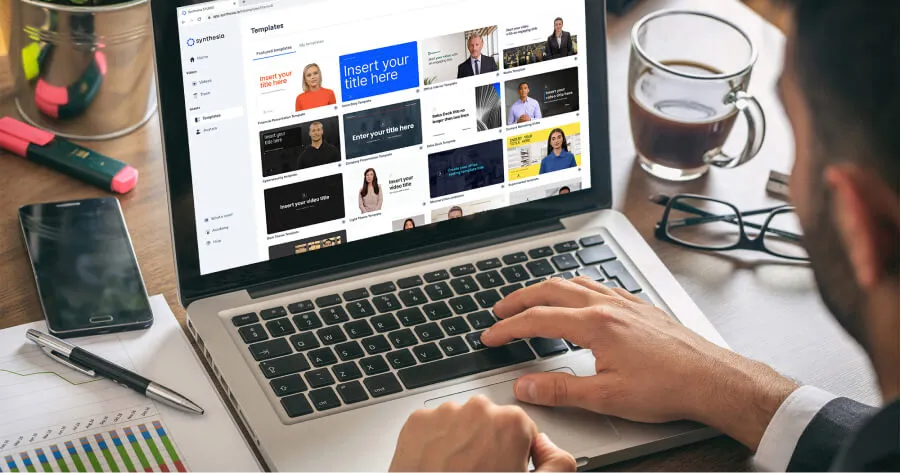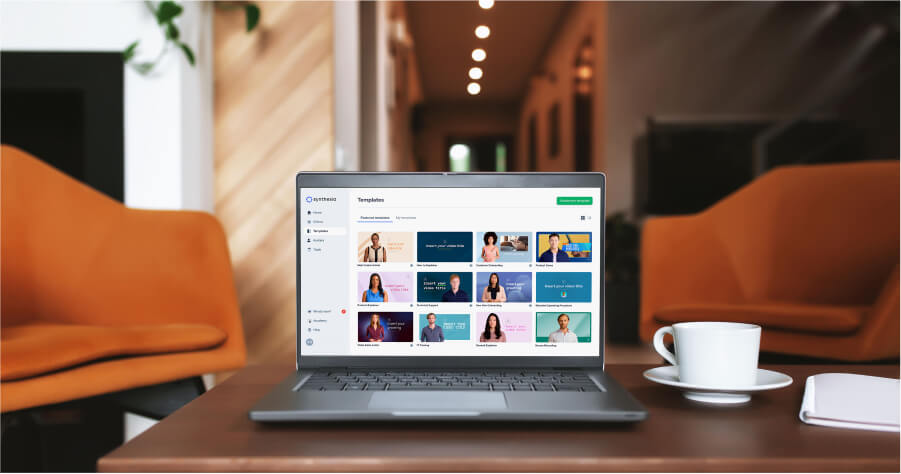

Turn your texts, PPTs, PDFs or URLs to video - in minutes.

Hey there! 👋
And thanks for landing here.
So by now you have probably seen Synthesia all over the internet and know what Synthesia is all about.
The next step is to learn how exactly you can use Synthesia to make videos, which is what this blog post is all about.
Without further ado, here's a step-by-step breakdown of how to make Synthesia videos. 👇
Step 1: Write a video script
A good video script in an essential foundation for both AI videos and traditional videos. So before you log in to Synthesia, take the time to plan out what you want your video to say and show.
How you write your script will depend on a lot of factors, like:
- Your audience and goal
- The type of video you want to make
- The visuals you want to include
We won't go into details on how to write a video script in this particular blog post, but we've covered the topic in depth here:
Step 2: Choose a video template of start from scratch
One your video script is ready, it's finally time to log in to Synthesia.
In the dashboard, you have a few different ways to start making a video:
1. Click on 'New video’ in the top right corner.Then, choose to either start a video form a blank slate or from one of the 55+ pre-designed video templates.
 |
2. You can also go to 'Templates’ on the left-hand side and start a video with a pre-designed video template.
3. Or, click on ‘Import PowerPoint’ to use your presentation slides as background in the video.
 |
If you're using a pre-designed template, you can add more scenes from the template by going clicking on + on the right-hand side of the video canvas.
There, you will see all the different video scenes that were designed to fit the template.
Choose as many scenes as needed.
 |
Step 3: Choose an AI avatar
Now it's time to choose which avatar(s) you want to use in your video.
To do that, simply click on 'Avatar’ on top of the video canvas and choose one that will fit your video.
 |
You will notice that most avatars come in multiple framings: waist-up and chest-up.
You can use the same avatar framing on all slides, or mix and match the framings in the different scenes to add visual interest to the video.
When you click on the avatar in the video canvas, an avatar layout window will pop up on the right-hand side.
In there, you can switch between displaying the full body avatar, a circle view, or no avatar (and only keep the voiceover).
 |
Please note, that the avatar doesn't move in the video preview, but only in the generated video. If you want to see what the avatar looks like when speaking, check out the avatar overview page or go to ‘Avatars’ on the left-hand side of your Synthesia dashboard, and preview the avatar.
Step 4: Paste script and create voiceover
With your layout all done, it's time to copy your video script and paste it into the script box scene by scene.
 |
You will notice that Synthesia automatically detects the language of the script and chooses a voice that fits the selected avatar best.
However, you are free to choose any voice you prefer by clicking on the voice selector in the top right corner of the script box.
 |
Step 5: Edit video
If you started making the video from scratch, now is the time to add the visuals, animations and transitions to make your video pop.
Here are some of the visuals you can add to your video:
Text
Click on 'Text’ on top of the video canvas, and choose between Title, Subtitle or Paragraph.
 |
You can adjust the layout the dragging the text box across the video canvas, or by adding precise coordinates in the right-hand side.
There, you can also change the font, color, size, style, spacing and alignment of the text.
 |
Shapes
To add a shape, click on 'Shape’ on top of the video canvas and choose one.
 |
To adjust the shape, click on it and head to the right-hand side to change the color, border, fill, opacity, shadows, layout and animation.
Images, videos, icons
For this, click on ‘Media’ on top of the video canvas.
In 'My library’, you can search for media you already used in Synthesia, find stock images and videos by going to 'Stock content’ or upload your own visuals by clicking on ‘Upload media’.
 |
Screen recordings
To record your screen, simply click on 'Record’ on top of the video canvas.
Once there, you can choose to record a specific tab, a window, or the entire screen.
 |
Afterwards, you can trim, loop, cut or stretch the screen recording to match your script.
Animations
To add Enter and Exit animations, click on the element you'd like to animate, and scroll down to the ‘Animation’ section on the right-hand side.
 |
Select your preferred animation type, and adjust the needed velocity, delay and duration.
Transitions
Similar to what you remember from PowerPoint, you can add transitions between individual video scenes in Synthesia.
To do that, click on a scene on the left-hand side and enable the 'Scene transition’ toggle on the right-hand side.
Once enabled, you can choose the needed scene transition.
 |
Music
Finally, to add music to your video, click on a scene on the left-hand side and enable the 'Music’ toggle. You can choose from different stock options or upload your own.
 |
P.S. If you started with a template, simply click on any visual element you'd like to change and adjust the layout, opacity, shadow, animation on the right-hand side.
Step 6: Generate and publish video
And you're done! 🎉
You can preview the video by clicking 'Play’ on the top right corner.
If you're happy with the preview, simply click on 'Generate'. You can fill out the video name, description, and include automatic captions, if needed.
 |
Your video will take a few minutes to generate, depending on its length.
Once it's generated, you can download, edit, or duplicate it.
 |
If you want to share the video, simply enable the ‘Enable video sharing’ toggle and copy the link.
 |
Are you ready to make videos in Synthesia?
Now you're a little more familiar with how to make a video in Synthesia step by step. But how do you know if the video you're making is actually good?
Check out our free FOCA video framework to learn how to make great videos. 👇
And if you're ready to start making Synthesia videos, but don't have an account yet - what are you waiting for? Click here to create an account.
About the author
Content Writer & Marketing Expert
Ema Lukan
Ema Lukan is a seasoned Content Writer and Marketing Expert with a rich history of collaborating with marketing agencies, SaaS companies, and film studios.

















